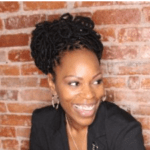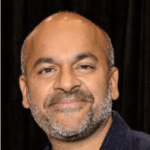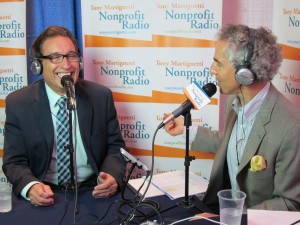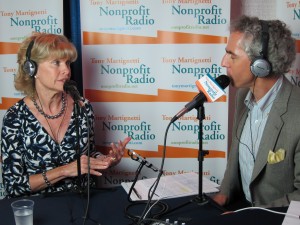
Peter Panepento & Antionette Kerr: Thought Leadership
Peter Panapento and Antionette Kerr co-authored the book, “Modern Media Relations for Nonprofits.” They share their insights on how to build relationships with journalists so you get heard as the thought leader you are. Plus, other media strategies, like crisis communications. This was part of our coverage of the 2020 Nonprofit Technology Conference.


Valerie Johnson & Katie Green: Content Strategy
Now that you’re an established thought leader, you need to produce multichannel content that’s relevant. Also engaging, actionable, user friendly and SEO friendly. Also from 20NTC, Valerie Johnson from Pathways to Housing PA and Katie Green with The Trevor Project show you how.


Listen to the podcast
Podcast: Play in new window | Download
Get Nonprofit Radio insider alerts!
I love our sponsor!
![]() Turn Two Communications: PR and content for nonprofits. Your story is our mission.
Turn Two Communications: PR and content for nonprofits. Your story is our mission.
We’re the #1 Podcast for Nonprofits, With 13,000+ Weekly Listeners
Board relations. Fundraising. Volunteer management. Prospect research. Legal compliance. Accounting. Finance. Investments. Donor relations. Public relations. Marketing. Technology. Social media.
Every nonprofit struggles with these issues. Big nonprofits hire experts. The other 95% listen to Tony Martignetti Nonprofit Radio. Trusted experts and leading thinkers join me each week to tackle the tough issues. If you have big dreams but a small budget, you have a home at Tony Martignetti Nonprofit Radio.
View Full Transcript
Processed on: 2022-11-07T18:43:05.596Z
S3 bucket containing transcription results: transcript.results
Link to bucket: s3.console.aws.amazon.com/s3/buckets/transcript.results
Path to JSON: 2022…11…618_tony_martignetti_nonprofit_radio_20221128.mp3.983343543.json
Path to text: transcripts/2022/11/618_tony_martignetti_nonprofit_radio_20221128.txt
Hello and welcome to Tony-Martignetti non profit radio big non profit ideas for the other 95%. I’m your aptly named host of your favorite abdominal podcast. I hope you enjoyed your thanksgiving. I hope you enjoyed the company of family friends, time for yourself as well. Lots of lots of good thanksgiving holiday wishes, I hope you enjoyed very much and I’m glad you’re with me. I’d be forced to endure the pain of epidermal Asus below psA if you gave me the blistering news that you missed this week’s show. Thought leadership, Peter Pan a pinto and Antoinette car co authored the book modern media relations for nonprofits. They share their insights on how to build relationships with journalists so you get heard as the thought leader you are plus other media strategies like crisis communications. This was part of our coverage of the 2020 non profit technology conference and content strategy. Now that you’re an established thought leader, you need to produce multi channel content that’s relevant, also engaging actionable user friendly and S. E. O friendly. Also from 20 N. T. C. Valerie johnson from pathways to housing P A. And Katie Green with the Trevor project. Show you how Antonis take two. I’m still wishing you well. We are sponsored by Turn to communications pr and content for nonprofits your story is their mission turn hyphen two dot C. O here is thought leadership with me now are Peter pan a pinto and Antoinette car. Peter is philanthropic practice leader at turn two communications, Antoinette is part of the leadership team of women advance and ceo of bold and bright media. They are the co authors of the book Modern media relations for nonprofits. Peter Antoinette welcome. Yes. I’m glad we could work this out among the three of us. Thank you. And uh, it’s good to know that you reach well and safe in your respective locations. Okay. [00:02:39.44] spk_1:
Thank you. Yes. [00:02:51.33] spk_0:
Okay. I, yes, I see. No one within six ft of you. That’s good. Even though you are home, we’re talking about thought leadership and media. Let’s, uh, let’s start with you Internet. We can, we can use our leverage thought leadership and use the media to, uh, to influence those who are engaged with us, our constituents and even influence policy. [00:04:02.66] spk_2:
So the media needs experts and non profits are on the ground there doing the work and they are the perfect folks to be experts in this conversation um, in particular and emergency Peter non talks about earlier about crisis communications and in a lot of situations the media scrambling looking for experts. If you have established yourself as a thought leader, which is what you should aspire to do. I know that turn to does the work in helping people to kind of establish themselves with the thought leader in this conversation. But right now we need people with good information and who can provide great stories for example and nonprofits can do that and they can do that work. And that’s why the thought leadership conversations important. Most nonprofits don’t see themselves needing to do that. It’s not the first thing we think about, we think about fundraising, right? Um, but not necessarily media friend raising. And so now is the time that you want to have those relationships and be considered as a thought leader. [00:04:18.59] spk_0:
Because when there’s news that relates to your mission, um, your call is more likely to be taken, your email is more likely be answered. If there’s that pre existing relationship you mentioned. But if if everybody in the sector is calling all the, all the media blindly, then it’s just sort of a crapshoot whether they answer you or not or [00:05:38.32] spk_2:
if you think about the media needing like, you know, going to a crisis example, like the media needing a source or an expert And they don’t want to quote the same person that’s, you know, something that I’ve learned from my media background and training. I’ve been working as a journalist since 1995. And you know, one thing that my editors say, you know, don’t quote the same person, don’t quote the same organization. So in a crisis people will call big box non profit sometimes. Um, and they’ll just see them as being the experts for a conversation. And that’s why establishing yourself as a thought leader is so important. So someone can say, you know, I’m a unique voice about this. We have an example in our book modern media relations where um, someone who an organization that worked with Children and families involved in domestic violence became very important in the conversation when a professional athlete in in Georgia was convicted of family violence and all of a sudden that person was called upon to be on radio shows and talk shows and they became a thought leader. But they done the work to position themselves as an expert. And so I know Peter you, I know you have some examples as well, but we just kind of dived in there and and didn’t talk about the whole broad concept about leadership. [00:06:04.05] spk_0:
Well, all right, well, um peter, I was gonna ask you, how do we start to build these relationships? Um you wanna do you want to back up what thought leadership is? [00:08:02.93] spk_1:
Sure, I’ll start with thought leadership defined and that and that’s really um the process of establishing one’s expertise in a in a specific area and and and doing it in a way where they are recognized beyond their own organization, in their own kind of immediate networks, as a, as an expert as a thought leader. Somebody who is driving the conversation and really really helping people better understand a key issue or a topic. So for a nonprofit or a foundation, a thought leader might be your ceo um who or executive director, somebody who um is at the front lines uh and and kind of is in a in a position where they um not only have expertise but they have some authority and being able to talk with some gravitas about a topic, um but um in order to kind of establish your credentials there um and get recognized, you have to do some legwork beyond just having that expertise. You have to be um you have to be comfortable talking about that topic. You have to um you have to spend some time kind of building the relationships and the and the and the the larger credibility that you are, somebody who has something interesting to say and the expertise to back it up. Um and the more you do that, and you can do that not just through the media, but through your own channels and through speaking at conferences and and all kinds of other things. Um the more you do that, the more you kind of become uh somebody who is recognized and is called upon to weigh in on important topics or or when news events call for it or in a situation like what, where we are now with with the covid 19 response, Somebody who can kind of come in and bring a voice of reason and perspective to what’s going on around us. [00:08:31.98] spk_0:
So you have to lay the groundwork there, there has to be some fundamentals and you have to have your gravitas and you you need to appear bona fide and be bona fide not just appear, you have to be bona fide on the topic that you’re that you’re an expert in the mission of, of your, your nonprofit. How do you then start to when you have that groundwork? How do you then start to build relationships when there isn’t really a need for you to be talking about the subject? [00:09:39.59] spk_1:
Sure, there are a lot of ways to do that one is that you, um, you start to build some personal relationships with media who are covering these topics. And you can do that either through, you know, somebody on your communications team that helps you, or you can kind of do it yourself, but you can, you can start to show up in, in their coverage of stories by, um, by um, positioning yourself and, and building relationships with individual reporters. Maybe even when they don’t need you by having an informational coffee or call so that they can get to know you and know what you stand for. Um, you can do it by your through your own writing and, and public speaking and making those things available and accessible to the media. Um, and you can, you can do it through your own channels to a lot of nonprofits have blogs, they have, uh, they have their own podcasts. They have different ways where they’re positioning their internal experts externally so that they’re kind of talking about and establishing their credentials around around a subject. And [00:09:41.01] spk_0:
that’s your, that’s your owned media, right. That’s your own media versus earned media? [00:10:12.00] spk_1:
Yes. Yes. And, and the value of that, is that the more you’re, you’re kind of demonstrating through your own media channels, your expertise, you’re not only building um some greater relationships and and credibility with your donors and the folks who are already kind of in your network, but you start to show up when people are doing searches or when people are on social media and seeing stories and articles that are passed around, if they may see something you’ve written or talked about, shared in another network, and it it sparks a light for them that you’re somebody worth going back to when they need, um when they need some, you know, somebody like you to weigh in on something. [00:10:52.96] spk_0:
Okay, peter, I know you and Antoinette are both former journalists. Uh, so I’m gonna jump over to Antoinette for what Antoinette, what what what do these outreach, I guess, calls and emails to journalists to try to build the relationship. Uh what what do they what do they look like? What would you suggest people are saying to, to try to get the attention um to build the relationship, not, not when I’m looking to be quoted because there’s a breaking news, but to build the relationship. [00:12:33.00] spk_2:
So, full disclosure. I’m a current journalist. Um so, yes, so I I still work for publications right now. Um and so people contact me on twitter and social media, which is a new thing. We talk about press releases. I’m a big fan of press releases, um yes, just full disclosure about that. But I still like for people to pitch me on social media, direct messages through twitter. If I’m using my company profile, it’s safe for nonprofits to contact me and say, hey, I have a story. I noticed that you’re interested in this concept, it’s always great when people know what I’m interested in. Like when they’re like, I noticed that you publish a lot of stories like right now I’m working on a story, a series of stories about missing and murdered indigenous women. And so when people see, oh, I notice you’re publishing stories about this and they pitch me on a direct message or um through facebook messenger even and say, hey, would you consider this the story and here’s the angle. Um or have you thought about, you know, I’ve had other people reach out and say I noticed you’re publishing these types of stories about, you know, missing and murdered indigenous women. Have you considered other stories about violence against women and it’s always a really great connection for me. So I think just kind of knowing what the journalist is interested in is really important, kind of, understanding their angle. Sorry, y’all, um understanding their angle and just flowing from there and saying, you know, here’s how we fit into this conversation is always a wonderful [00:12:46.00] spk_0:
um so outreach by any of the social channels is fine too, you talk about twitter and direct message facebook, those are all [00:12:56.47] spk_2:
yes and people tagging me like I feel like if a journalist is using their profile in a way that is professional then you’re safe to contact them and them in that way. [00:13:11.60] spk_0:
Okay. Yeah, yeah peter anything you want to add to? Yeah, I think [00:14:13.09] spk_1:
that I think is dead on about making sure though that when you do that, you are, you are, you’re you’re not coming with something that’s off the reporters beat or off of um what’s what, what you know, is um what they cover uh or the type of story they cover within that beat. Um you could spend a lot of effort reaching out to every journalist you see on twitter about your specific cause, but if they don’t cover your cause um you know, it doesn’t relate to what they what they do, then they’re probably either going to ignore you or or start to block you because you’re, you’re, you’re kind of almost spamming them. So um it’s it’s important to be targeted with who you reach out to as well and and make sure that you understand that journalists and their work before you before you do your outreach and come at them with a pitch that they don’t necessarily want. So yes, I think it’s really important to to do a bit of that homework up front um and respect that journalist time and if you do that and if you come at them with something that is actually on, on their beat and is of interest to them. Um, then I think you have a much greater chance of getting their attention and getting them to want to follow up with you and and help further, um, the relationship beyond that initial pitch [00:14:32.47] spk_0:
and [00:15:31.85] spk_2:
Tony, can I share a pet peeve like to Pet peeves actually is, um, if I write about a non profit and they don’t share the story on their own social, it’s just, it’s heartbreaking for me. Um, a lot of times I have to fight for these stories to appear and I have to fight with an editor to say, this is why this is newsworthy. This needs to be here. And then the nonprofit really doesn’t share the story. And I think, well, you know, I don’t write for my own, you know, just for it not to be shared. Um, and then the other thing is I love when nonprofits support stories that aren’t related to their particular story. So I’ll start noticing like one thing, um, Kentucky non profit Network, for example, before they ever shared or were involved in anything that I was involved in, they started sharing things or liking things that I would publish as a reporter and I didn’t know anything about them, but I thought that was interesting. So that when they pitch something, then you’re more likely to notice it as a, as a reporter, you’re more likely to notice because you feel like they’re really genuinely interested in the conversation, even if it doesn’t apply to them, you’re still interested [00:15:51.29] spk_0:
Internet. Where are you writing now? [00:15:58.07] spk_2:
I am writing, working on a piece for Guardian. I am for the Guardian. I am writing for Women Advance, which we have our own network. And then I write for Halifax Media group publications. So I’m on the regional circuit, doing all the fun things. [00:16:13.38] spk_0:
Halifax is nova Scotia. [00:16:22.99] spk_2:
No, Halifax is a media group in the United States. They own a series of their own regional newspapers across the country. So [00:16:28.59] spk_0:
let’s talk a little about crisis management. You wanna, can you get us started with how you might approach crisis communications Antoinette. [00:16:38.11] spk_2:
I thought that was Peter’s question. I’m just kidding. [00:16:40.29] spk_0:
No, [00:16:41.31] spk_2:
I’m just kidding. Um, crisis communications, I think actually Peter is a really great person to talk about this. My crisis communications conversation really has shifted with what we’re going through. So I don’t want to make it so unique to our current situation. Um, so I’ll let Peter start and then Peter, I can back you up on it if that’s [00:18:50.46] spk_1:
okay. Yeah. So, um, with crisis communications, it’s really important to not wait until the actual you’re actually in a crisis to put your plan together. It’s really important to, to have a protocol that you’ve set up when you’re not in the middle of a crisis of possible to really kind of put together uh some protocols for not only what you’re going to say, but who’s going to say it and how you’re going to communicate during that situation. So um what does that protocol look like one? Is that you um upfront, you designate who your spokesperson or spokespeople are going to be ahead of time um and you spend some time ahead of that coaching them up in terms of what some of the key messages for your organization are, regardless of what the crisis might be. Some things that you would broadly want to try to reinforce and kind of a mood and a tone that you’re gonna want to take with what you’re talking about. Um do that 1st 2nd, is that you would really want to have a system in place for how you activate that for how you activate your crisis plan and your crisis communications. So that essentially means that you want to um you want to make sure that you know, kind of who who needs to sign off on what you’re going to talk about, who you’re gonna be involving in your decisions on whether you need to put out a statement um who how you’re going to communicate in what different channels, the more you can make those decisions ahead of time and have your structure in place, the better equipped you are to actually respond during a crisis situation and be able to get a quick and accurate and positive message out um in in in a situation and often crises are not their crisis because they’re not expected, but you can be planning ahead so that you you are able to react quickly and authoritatively during that situation. Um [00:19:07.87] spk_0:
you’re you’re compounding the crisis if you’re not prepared. [00:19:12.53] spk_1:
Absolutely, [00:19:13.33] spk_0:
You’re scrambling to figure out who’s in charge, who has to approve messages, where should messages go? All, all which are peripheral to the to the substance of the problem. [00:20:12.02] spk_1:
Absolutely. And in today’s world, where crisis can really mushroom not only in the media, but on social media, the longer you’re allowing time to pass before you’re getting out there with with your statement and your response to it, the worst the worst the situation gets for you. So you really need to position yourselves uh to be able to respond quickly to respond clearly and to respond accurately. Um and and it’s important to note that, you know, that planning ahead of time is really critical, but what you say in the situation is also critical to um you do want to make sure that you communicate truthfully. That doesn’t necessarily mean that um uh you uh u um reveal [00:20:14.17] spk_0:
everything, [00:20:14.72] spk_1:
reveal everything [00:20:15.67] spk_0:
exactly [00:20:18.45] spk_1:
do uh that you do reveal is accurate. It’s not gonna come back to bite you later. It’s not going to mislead people [00:20:31.86] spk_0:
talking about complicating the complicating the crisis if you’re lying or misleading, it comes back. I mean, people investigate things get found out. [00:20:36.17] spk_1:
Absolutely. And I, and I, and I was [00:20:38.82] spk_0:
technically expanded your problem. [00:21:42.71] spk_1:
Absolutely. And and you’d be surprised how, how many times when I was a journalist that people, if they had just come clean and and kind of got the truth out there right away, they may have taken a short term hit, but their lives would have got on fine after that. But the more you try to obfuscate or or lie about the situation, or or try to to spin it in a way where you’re, you’re kind of hiding the truth that the worse your situation is going to get. So be be in a position to be as transparent and clear and accurate as possible. Um, with that first statement, uh, knowing that in some cases you might have to say, you know, we don’t know. Um, but we’ll follow up when we do know, because sometimes a crisis situation is one in which speaking of, of when we’re in now, we don’t know all of the, all of the different twists and turns the covid 19 situation is going to take. Um, so, but but rather than trying to speculate, um or or or in some cases, as we’ve seen, some, some public figures do try to spin this one way or another, rather than just saying, here’s the situation here are concerns, Here’s what we know, here’s what we don’t know. Um, it compounds the situation and in some cases it can be dangerous to [00:22:01.82] spk_0:
people internet, You wanna, you wanna back up a little bit? I [00:22:38.74] spk_2:
Did. So the, I think the statement, um, I love how people are putting forward these COVID-19 statements and I think we need to have more statements like that. I mean these statements are demanding and people feel like that. But I’m like we could do more of that. We could have statements as nonprofits on issues on public issues, public concerns, things that are um, emerging and urgent for people. I think about in the eastern part of north Carolina because tony I know you’re in, in my home state. I am [00:22:40.58] spk_0:
in eastern north Carolina. [00:23:26.54] spk_2:
Happy to have you here. And when we have um, hurricanes, when we have issues like that, if non profits would put out statements like they have with Covid 19 if they felt like they needed to say here’s where we are, here’s what we do here. Here’s, here’s what we have to offer before during after and just update them. You know, I feel like this crisis has brought forward a level of communication and and help people to see the necessary level of communication that we need to have. But we don’t have that all the time is non profits and people are looking for that. So I feel like in the eastern part of north Carolina where we had, um, you know, 100 year, hurricanes within three months of each other that we didn’t think would happen. You know what if people, what if people make covid statements like that? I mean, what if people and so I’m just gonna start calling the covid statements peter that I don’t have a better term for. But what if we felt like we needed to make these types of statements when there’s an emergency, [00:23:51.92] spk_0:
um, Antoinette, I’m gonna ask you to wrap up with something that you said, which is contrary to a lot of what I hear. Uh, you said that you’re a big fan of press releases. [00:24:02.00] spk_2:
Could [00:24:03.26] spk_0:
you take us out with your rationale for why? You’re a big fan of them. I’ve heard that they’re pretty much obsolete [00:24:10.20] spk_2:
from a journalist. I [00:24:12.51] spk_0:
don’t know from a commentator. I [00:24:14.37] spk_2:
don’t want to write that. [00:24:17.47] spk_0:
I [00:24:27.93] spk_2:
believe that. I believe that. Um, so yes, because I’ve been reading press releases for a long time and I feel like the who, what, when, where and how gets me past that part of it, then I can ask you all the interesting questions. So if you can give me that in a way that I can cut and paste and I will not butcher someone’s name, like tony [00:24:43.54] spk_0:
It [00:24:55.22] spk_2:
might be, it might be a challenge. So I can, we can get all of that out of the way. But a good press release gets me excited as a journalist. It brings me into the conversation and if you aren’t excited about your press release. I can probably tell on the other end. So I had a good press release. All [00:25:15.51] spk_0:
right, thank you. We’re gonna leave it there. That’s contrary advice. Which which I love hearing. All right. That’s uh that’s Antoinette car part of the leadership team of women advance and ceo of bold and bright media and also Peter Pan a pinto, philanthropic practice leader at turn two communications and they are co authors of the book modern media relations for nonprofits, Antoinette Peter, thank you very much for sharing. Thanks so much. Thanks for [00:25:28.62] spk_1:
having us. tony [00:27:19.59] spk_0:
pleasure. Stay safe. And thank you for being with tony-martignetti non profit radio coverage of 20 N. T. C. It’s time for a break. Turn to communications. Well, as you heard lots of ideas about the relationships, the relationships that will help you be the thought leader that you want to be. That you ought to be relationships leading to thought leadership. Turn to communications. They’ll help you do it. Your story is their mission turn hyphen two dot C. O. It’s time for Tony’s take two. I am still thinking about you and wishing you well. I hope you had recovery time over Thanksgiving. If you’re in giving Tuesday, I hope you’ll be happy with your results or you are happy depending when you listened. If you are, if you did congratulations, celebrate what you achieved. Take that victory lap you deserve it. If you’re not so happy, keep your head up, you know that you did the best that you could, don’t let it drag you down. You have other successes that are gonna be coming and you’ll be celebrating those. So don’t let a disappointment drag you down going forward. You have all my good wishes for your year end fundraising this week and continuing That is Tony’s take two here is content strategy, which by the way, we have boo koo, but loads of time left for Welcome to tony-martignetti non profit radio coverage of 20 N T C. That’s the 2020 nonprofit technology conference. My guests now are Katie Green and Valerie johnson, Katie is Digital Giving Manager for the Trevor Project. And Valerie johnson is director of institutional advancement at pathways to housing P A Katie and Valerie welcome. [00:27:44.11] spk_3:
It’s [00:28:07.84] spk_0:
a pleasure. Good to good to talk to both of you and glad to know that you’re each safe and and well in in Brooklyn and uh, suburban philadelphia. Glad you’re with us. Your NtC workshop was content strategy for donor engagement From tactics to testing, let’s start with you, Katie, what what do you feel was the need for the session. What are nonprofits not getting doing so well, they could be doing a lot better. [00:28:57.87] spk_3:
Yeah. So we have this session this morning at the same time as we originally had planned, which is great. We were able to give it virtually. And I think what a lot of donor content strategy is missing is simply structure. I think a lot of people don’t know where to start and they’re intimidated by it and we Valerie and I provide it’s some real life examples on how you can achieve a donor content strategy that does get you closer to your revenue goals. However, the tone of the presentation changed a little bit given how the world has come to be our new reality. So we did talk a little bit about the crisis and what it means for fundraising and what it means for content strategy under a tight timeline, knowing that things are changing at a really rapid pace. So really just structure and storytelling are the things that we talked about in this morning’s presentation, which will be available for viewing later, we’re gonna have a recording available for those who weren’t able to make it. But yeah, that’s what we focus on. [00:29:27.47] spk_0:
Let’s start with part of the a good strategy is using personas, user personas. Can you kick us off with that Valerie? How do you, how do you start to identify what persona looks like and what’s their value? [00:29:54.36] spk_4:
Absolutely. So, a persona is really like a profile or a character sketch of someone that you need to connect with um and understanding their motivations and goals. So it’s a way of segmenting your audience. And rather than sending all of your messaging out into the ether, trying to tailor that messaging to a specific demographic or a specific group of people. So for pathways to housing P. A. We’re actually still developing what our personas look like. We have an idea of what it looks like, but we want to dig some more into the research and analytic side of things to see who exactly is supporting us right now and what um ties they have in common to help us build those profiles. I think Katie might be a little bit further ahead of us in developing this persona. So I’m gonna toss it over to her. [00:31:18.60] spk_3:
Yeah. So uh user personas are something I’ve been doing throughout my career. I worked in an agency before I came to the Trevor project. So I was able to get a lot of industry knowledge on how we create user personas and user journeys. But what we did, when we started looking at our end of year campaign for last year at the Trevor project, we made sure we carved out some time to conduct a little bit of an audit of what our donors were looking like, Where were they coming from? What could we track? What could we track? We found out we had a lot more questions than we did answers. So in order to get user personas, something that’s really important is tracking and understanding where people are coming from and where their first and last last clicks are. So because of our ability to use google analytics and source code tracking protocol. We did get a lot of tracking during end of year that will improve what our users like going into future campaigns. But now we’re gonna be able to better tell what is actually inspiring people to give. What is the moment where they’re actually clicking that donate button. What is the first thing they’re seeing that starting their relationship with the trouble project? So that’s what we’ve been doing. [00:31:45.74] spk_0:
What are the pieces of a persona? How granular do you get? What is it where they live to what they read or what what you give us some like depth of this thing. [00:33:34.60] spk_3:
Absolutely. So the main important piece of a persona is to know what their needs are. So you can have a persona that’s as general as this is a donor. They need to know how to give that’s a persona. But what you’d like to do is get a little bit deeper in being able to tell what the values of that persona are. What’s what’s the name? What’s the age? What’s the key characteristics? What are the opportunities really? You know, I like to create fake names and really go into it. You stock imagery so that you can try to connect with who this person might be? You’re really giving a face to a name and a value to a person and you want to look at what donors are looking like. So for example, for the Trevor project, we have a lot of one time, first time donors and we have a lot of people who come in, they give their first gift and I’m trying to find where they’re dropping off. Right. What is causing that? So I maybe create a persona that is a one time user that’s not really convinced they want to give again a one time donor. Um, they may be young. They may be, um, like within our demographic, which is under 25 of the youth that we serve with our crisis services and suicide prevention services. Um, so you can get as granular as making and they, and an age and the demographic and the location and what devices they’re using. I think that’s a big one. Is this person usually on their mobile? Are they usually on desktop? What channels do they typically like to look at twitter? You can get as granular email. Are they just looking at your website? So you know, it should get as detailed as you can, but I would encourage people to get really creative with it. If the more details you’re able to get is just a, just a more clear picture of a donor that you’re looking to target. Just make sure it’s someone you actually want to target and not someone you’re gonna be, uh, that wouldn’t actually be coming to you? Like maybe Bill Gates isn’t going to be coming to, uh, a nonprofit website to donate. Um, but you can look at what those specific donors might look like that are more realistic for your campaign. [00:33:56.12] spk_0:
Okay. Right. You’re, you’re basically on what’s realistic, not what your aspiration is. [00:34:22.36] spk_3:
Yeah. To a degree, I mean, I think you can be aspirational aspirational in some facets of what you’re doing. I think it has to be somewhat grounded in in, you know, a realistic approach. We do get asked. I get aspirational myself when I’m creating donor personas. When you know, I am looking for major gifts, I am looking for people who are willing to process of 15,000 dollar credit card charge. And there are people out there that that do that. So when I do my donor personas, they may not be the number one target of my campaign, but I do want to consider what those people are interested in as well so that I can personalize content for them to the best of my ability. [00:34:53.03] spk_4:
Yeah. The other thing to keep in mind is diversifying your donor base. So in looking at who’s giving two pathways to housing right now, they’re mostly middle aged, college educated white women who prefer facebook and giving on a desktop, um, which is fine. And that’s definitely one category of people that you would want to be supporting you. But philadelphia is an incredibly diverse city. So if those are the only people that were getting to with our messaging, then we really need to think about diversifying our strategies to build new donor profiles for people who don’t all look the [00:35:36.72] spk_0:
same? Okay. And then once you have a bunch of personas and profile? I mean, it sounds like you could have 10 or 12 really different ones, different, um yeah, different characteristics of people, different types of people that come to you. And, and like you said, Katie, even people who leave, you know, you want to capture them back. So, so once you have these Valerie, then you’re trying to communicate to them. But how do you how do you turn your communications into targets to to these personas? [00:35:46.68] spk_4:
So you really want to think about building content specifically for that persona? So you might be doing a campaign um that you want to hit a couple of different [00:35:56.37] spk_3:
personas [00:36:07.97] spk_4:
with, but you’re gonna tailor that campaign specifically to each persona and deliver the message to a specific segment of that campaign. So if you’re gonna do a mail campaign, um, you want to think about how you’re putting together that letter and what you’re writing into the letter and how you’re addressing the donors for each of the different segments for each of the different personas that you’ve put together to really help craft a message and to inspire them specifically to donate. [00:36:32.48] spk_0:
Okay, right, like Katie, like you were saying, you know, yeah, you know what’s important to them. Um, but that stuff is, this is very uh amorphous to try to, you know, it’s not just what do they give and how much do they give? And what time of year do they give, You know, what’s important to them? What do they value? This? Is this is difficult stuff to suss out. [00:37:10.42] spk_4:
Yeah. One thing our co presenter said this morning, Marcus was that donors are smart and they’re savvy and with the advent of the internet and all of the various channels that you can communicate with people now, they know what they want and they know what they want to hear from you. And if they’re not hearing from you what they want, they’re gonna go find someone else who’s going to provide that information and communicate to them the way they want to be communicated with. So fundraising and marketing for nonprofits right now looks very different than it did maybe 10, 15, 20 years ago, um, and, and donors know what they want now. [00:37:24.54] spk_0:
Okay, so it’s worth, you’re trying to suss out all this amorphous information as as best you can. Okay. Um, Katie, is there anything more you want to say about personas before we move on to being multi channel? [00:37:36.13] spk_3:
Let’s go on to multi channel. [00:37:40.11] spk_0:
Alright, Alright. Anything I don’t want to leave anything important. [00:37:44.66] spk_3:
Okay. I think we’ve covered the main point. [00:37:47.19] spk_0:
Okay. What’s, what’s, what’s important about? Well, I think we all know why to be multi channel, but how to coordinate those messages? What what’s your, what’s your thinking there? [00:39:21.81] spk_3:
Yeah, I can jump in here. So I think what people often don’t do is they don’t coordinate messages cross channel at the right time. That’s what I’ve been seeing a lot with just by industry research. I mean, I’m always looking at what everybody is doing in the space because I want to be part of the best. Uh but they say being what I’ve heard at multiple conferences is that there’s a rule of seven. Right. So as a non donor, let’s say, I’m scrolling through facebook, I need to see an ask seven times before I’m actually likely to give. So if you’re seeing that ask seven times on facebook, that means it’s seven posts. That’s kind of a lot. And that’s gonna have to be spaced out through a certain amount of days, weeks, months even. So if you’re just increasing all the channels that you’re presenting that message on. So let’s say I’m seeing it on facebook, I’m seeing it in my email. I’m seeing it on my instagram. I’m getting a paid ad for it because I liked it on facebook. That’s gonna shorten the window of which I see seven points of that call to action. So I’m gonna be more likely to give if I’m seeing it in a wider spectrum on the digital space than I am in just one channel. So making sure that you’re saying similar things, but that are custom to what the channel is providing, Like social media has like paid ads have a certain amount of characters you can use. So, um, making sure it’s optimized for what channel you’re using, but still with the common thread is really important for increasing your conversion rate. [00:40:05.59] spk_0:
Okay, now it’s a little clear to me why I see so many ads for the uh, pickpocket proof slacks. I see them across all kinds of different channels. I’m not, I’m hardly on facebook anymore. But um, I, I see them when I go to websites and I’m reading articles and because one time, I don’t know, I, I swear it was like three years ago I was browsing through these like CIA approved slacks with 14 pockets and it’s all supposed to be pickpocket proof for something and you know, they $200 slacks or whatever, they’re, you know, but [00:40:08.62] spk_3:
I’ve [00:40:09.74] spk_0:
seen ever since. Yeah. And I don’t know. I’m not even sure that if I bought them, the ads would stop, maybe [00:40:16.43] spk_4:
it’s [00:40:17.57] spk_0:
sophisticated enough. No, it’s not right. That would be right. Because now your brother needs to pay or whatever. All right, [00:40:23.00] spk_3:
Valerie, [00:40:24.15] spk_0:
anything you wanna, you wanna explain about multi channel and how, how important it is to reinforce and be consistent. [00:41:16.62] spk_4:
I think the biggest thing for me is if you’re starting from scratch and you’re really trying to develop content and put it in the right places. Um, you really want to be thinking about who your audience is on those channels. So for, linkedin, the messaging that you’re putting out is gonna look a lot different than what you’re putting out on facebook. Most people use facebook recreationally and they use linkedin for professional relationships. So the type of information that someone is seeking on linkedin or more likely to respond to on linkedin is a lot different than what they’re more likely to look for or respond to on facebook. Um so for us, we make sure all of our job listings go up on linkedin and all of our industry specific information that goes up on linkedin, um just to kind of show our expertise in the area. But when we’re posting to facebook, we’re talking more directly to people that we know are supporters of us and want to do tangible things to support us. So the messaging is different, even though the information is really the same. [00:41:31.44] spk_0:
Okay, okay, again, you’re consistent but consistent, but but different. Maybe different format even. Um Okay. [00:41:39.99] spk_4:
Yeah. [00:41:52.00] spk_0:
Um I mean, there’s there’s other format, you know, content papers, white papers. Um Again, depending for the right, you know, for the right channel research, um, do either of you use um, media, uh, working in working through thought leadership in developing thought leadership in media media relationships either of [00:42:30.91] spk_4:
you. Yeah, so there’s a local media outlet here in philadelphia called generosity and they are focused on nonprofits and social enterprises and people who are making positive impact in philadelphia. So they’re super open to having folks guest post um, or write op EDS for them. So we’ve utilized that outlet a couple of times. Um, actually just last week, um, our ceo over wrote an article about the opportunity for kindness in the era of coronavirus. So it’s something that she actually wrote to communicate to our staff members and let them know what our stance on, you know, moving forward was going to be. And we thought it was something that would be beneficial, not just to our staff but to be at large. So we passed it along to them. They posted it as an op ed and that gave us um, a little bit more bang for our buck for things that we had already [00:42:58.94] spk_0:
written. Um, Katie, are you doing much with earned media? [00:43:03.08] spk_3:
I am not the Trevor project is, but Katie Green is not doing that. Okay, handled that. [00:43:10.85] spk_0:
Okay. Um, let’s talk about some, some analytics. I mean, how do we know whether we’re being successful? Uh, and where we need to, where we need to tweak or pivot Katie, can you, can you get us started? [00:44:29.28] spk_3:
Absolutely. So analytics is very hard for a lot of nonprofits because it’s such a scientific based skill set. And you know, that’s something that when I first came onto the Trevor project, is that the first thing I implemented was our source coding protocol. It’s so important to know where people are coming from that you can actually optimize, but we a B tested and continue to A B test absolutely everything. We do it through our website, we do it through email, we do it through our paid social and to see how things work. I think really we just test absolutely everything things you think you know you don’t and that’s what I keep learning through testing is what you think works today, won’t work tomorrow and we retest everything. A time of day test for example isn’t gonna for ascend for email, isn’t gonna be the same after daylight savings. It’s not gonna be the same as the seasons change and particularly not the same now that everybody is stuck at home. So you know they’re testing and optimizing really what you know is working. It just requires retesting re optimizing and testing literally. [00:44:35.20] spk_0:
Could you, could you give some more examples besides time of day, what are examples of things you test? [00:45:24.47] spk_3:
Oh absolutely. So on our website we tested, we have a little um call out box with questions on our donate form. We tested the placement of that. Is it better to have it right up next to the form underneath directly on top. So the first thing people see um we test there, we test what photos we use a lot does a photo of somebody looking sad versus somebody looking more celebratory and happy. Um we test a lot of pride imagery because we serve LGBTQ youth. We wanna see if Pride imagery actually helps get our word out there. Um We test our colors a lot because our our brand color is orange which is can be very cautionary but we see you thing oh it’s your brand color. Of course everybody’s gonna always respond to it. But that’s not really the case. Like sometimes things like our blues and purples and greens when it comes to see ta buttons. Um Gosh, I mean I can tell you every test we’ve ever run. Thunder tests um using graphics versus photos on the website. Uh you know the size, the width, the height of our light boxes, the width of our donation forms the amount of buttons we have. It just the list goes on and [00:45:51.24] spk_0:
on. [00:45:53.35] spk_3:
I [00:46:13.51] spk_0:
heard one that just made me think of just one small example of what riffing off what you just said was testing the text inside a button instead of just donate or like uh review or something. You know, be more be more explicit about what the what the action is you’re asking for instead of just a single word. A little little more descriptive. Yeah [00:46:32.93] spk_3:
testing C. T. A. Is is something that we do a lot just to give people some ideas. I think one that can be really helpful when it comes to fundraising is seeing how your donors react to the word give and the word support and the word donate. So so it’s all the same thing. We’re asking you to support our mission to give to us and to donate. But those three words have very different feelings when you’re reading them on your screen. So that’s one of the biggest tests we ran. Um, but yeah, I wouldn’t recommend always testing the C. T. A. When you have a new one especially, [00:47:09.95] spk_0:
was it, was it act blue that or or change dot org? I think maybe it’s change dot org started calling it chip in. Could you chip in? Okay. Okay. Um, um, so Valerie, can you talk us through some metrics? You’re the director of institutional advancement? What what numbers do you look for to decide how you’re doing? [00:48:23.15] spk_4:
Uh, we look at a lot of things. So we’re looking at the click through rates on our emails and on our post actually reading to the bottom and clicking the links that we’re providing. Um, we’re looking at how many people are interacting with things that were posting on social media and whether they are enjoying it or not based on how many people are interacting with it. Um, we do a lot of surveys to do, so, talking to our donors directly and asking them what kinds of things they want to see what kinds of things they don’t want to see. Um, I know Katie is doing a lot more with metrics than we are. So, um, this is my friendly reminder to smaller nonprofits where there’s just one person trying to do all of this. you don’t have to recreate the wheel. Um, so you can look at an organization like the Trevor project that does have the staff who can look at all of these things and do all of these testing and all of the metrics and see what’s working best and they say imitation is the sincerest form of flattery. So you can look at what they’re doing and then borrow it. Um, so for an organization like me that has a smaller staff, um, we’re doing a little bit on our own, but we’re also looking a lot at what other nonprofits are doing and assuming that they’re taking the time to test things and we’re kind of, you know, copying what they’re doing because it’s obviously successful for them. [00:48:36.00] spk_0:
How do you learn from them? Do you just create a build a relationship and then ask what, what kind of metrics do you look at [00:48:54.20] spk_4:
sometimes? And sometimes it’s as simple as going to the Trevor project, websites donate page and seeing where they place things and what they name their buttons and what giving levels they’re putting up there. Um, because you know, you’re never gonna be exactly the same as another organization. So you definitely want to take a look at who you’re using as an example and use someone who’s doing similar work or in a similar location to you. But at the end of the day, there’s only so much you can learn through testing and after that you’re just gonna have to dive in and do something. So if you don’t have time for the testing, you can do a quick search of what everybody in your industry is doing and kind of take it from there instead, [00:49:20.34] spk_0:
Katie, uh, since everybody’s stealing from the Trevor project, what, uh, what I assume you knew Valerie was doing this. [00:49:28.27] spk_3:
I didn’t, but it’s, it’s such a compliment. [00:49:31.09] spk_0:
It’s [00:49:32.63] spk_4:
because you do a great job. That’s why we’re looking at [00:49:35.06] spk_3:
you. Oh gosh, [00:49:36.48] spk_0:
what do you want to add about metrics? [00:49:59.95] spk_3:
Um, I think I just wanna reiterate Valerie’s point that there are so many nonprofits where one person is doing this. Um I’m the only person on the digital giving team. I’m the first person they’ve ever hired to do Digital giving. Um I’m still a team member of one, but you know, I do have the support of a very large marketing team that helps me with creating all of the tests that we do and anyone can tweet me email me whatever if like any nonprofit ever wants to connect. I’m always an open resource. But uh, metrics are increasingly uh important, just critical to donors, content strategy. So [00:50:21.55] spk_0:
since you’re offering yourself as a resource, do you want to share your email and or your twitter, you don’t have to give your email if you don’t want to. [00:50:28.72] spk_3:
Yeah, maybe twitter is probably the best way to reach me because I’m trying, I’m trying to learn how to tweet more as a digital person. I feel like I need to, that it’s at Katie Sue Green like one word, so it’s K A T I E S U E G R E N K T. Still green green, just like the color. Okay, [00:50:51.53] spk_0:
Okay, thank you. Um it’s a Valerie, you wanna uh wanna wrap us up some some parting thoughts about uh content strategy. [00:51:18.42] spk_4:
Sure. Um since I am kind of representing the smaller organization here, I just want to remind everybody that you’re doing everything that you can and it’s everything that you’re doing is important. So don’t try to do everything at once, really pick one thing to focus on and get to a point where you’re doing that well and comfortably before you try to add more um listening to a podcast like this or going to a presentation, like the one that we did this morning is overwhelming in the number of things that you could be doing and it makes you feel like you’re not doing enough, but you are. And just tackling those small hills one at a time is much much easier than trying to climb the mountain. [00:52:42.29] spk_0:
That’s very gracious, very gracious advice. Thank you. Thanks very much. Um that was Valerie johnson, that is Valerie johnson director of institutional advancement at pathways to housing P A. And with her is Katie Green Digital Giving Manager for Trevor Project. Thank you very much for sharing each of you. Thanks so much And thank you for being with Tony-Martignetti non profit radio coverage of 20 NTCC in two weeks. Trafton Heckman with his book, Take Heart Take Action next week, I’m working on it. If you missed any part of this week’s show, I Beseech you find it at tony-martignetti dot com were sponsored by Turn to communications pr and content for nonprofits. Your story is their mission turn hyphen two dot c o Our creative producer is Claire Meyerhoff shows, social media is by Susan Chavez. Mark Silverman is our web guy and this music is by scott Stein, Thank you for that. Affirmation Scotty B with me next week for nonprofit radio big nonprofit ideas for the other 95% go out and be great.









